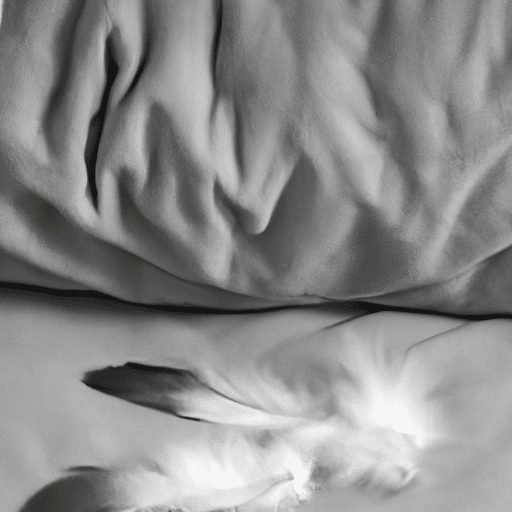In today’s article, we are going to explore the fascinating world of pillows and decode the differences between down and feather pillows. We all know the importance of a good night’s sleep, and having the right pillow plays a crucial role in achieving that ultimate comfort. So, if you’ve ever found yourself lost in a sea of pillow options, fret not, for we are here to shed some light on the distinction between these two popular pillow choices. Join us as we unravel the mystery behind down and feather pillows and discover which one might be the perfect fit for your slumber needs.
Review contents
Down Pillows
Construction
When it comes to the construction of down pillows, they are typically made with a combination of down and feathers. The outer fabric shell is usually made of high-quality cotton or a blend of natural fibers. These shells are tightly woven to prevent the down and feathers from escaping. Inside the shell, there are baffles or chambers that help to distribute the filling evenly and prevent clumping. This construction ensures that the down and feathers stay in place, providing consistent support and comfort.
Filling Material
The filling material of down pillows is primarily composed of down and feathers. Down is the soft and fluffy part found underneath the outer feathers of waterfowl, such as ducks and geese. It is known for its exceptional loft and insulation properties. Feathers, on the other hand, are the outer, stiffer, and more supportive part of the bird’s plumage. The combination of down and feathers creates a balance between softness and support, making down pillows a popular choice for many sleepers.
Softness and Comfort
One of the key advantages of down pillows is their exceptional softness and comfort. The down filling provides a luxurious and plush feel, making you feel like you’re sleeping on a cloud. The natural loft and resilience of down allow the pillow to conform to the shape of your head and neck, providing gentle support without pressure points. This softness and comfort contribute to a restful and rejuvenating sleep experience.
Insulation and Breathability
Down pillows are renowned for their excellent insulation and breathability properties. The inherent loft of the down clusters creates air pockets that trap heat, keeping you warm during colder nights. At the same time, these air pockets allow for proper airflow, preventing the pillow from overheating. This optimal balance between insulation and breathability ensures a cozy and comfortable sleeping environment throughout the year.
Durability
When it comes to durability, down pillows are generally long-lasting if properly cared for. The high-quality construction and tightly woven fabric shell help to prevent the down and feathers from escaping. However, it’s important to note that down pillows may require occasional fluffing to maintain their loft and support. With proper care and maintenance, down pillows can provide years of luxurious comfort.
Allergy Concerns
While down pillows are known for their superior comfort, some individuals may have concerns regarding allergies. It is important to note that allergic reactions to down are relatively rare, as the down undergoes extensive cleaning and sterilization processes. However, if you have a known allergy to feathers or down, it is advisable to opt for pillows made with synthetic or hypoallergenic fillings instead.
Price Range
In terms of price, down pillows are typically more expensive compared to feather pillows due to the higher quality and premium materials used. The cost of a down pillow can vary depending on factors such as the quality of the down and feathers, the thread count of the fabric shell, and the brand. While down pillows may require a higher upfront investment, many people find that the luxurious comfort they provide is well worth the price.
Care and Maintenance
To ensure the longevity of your down pillow, proper care and maintenance are essential. Fluffing the pillow regularly helps to restore its loft and prevent clumping. In terms of cleaning, it is recommended to follow the manufacturer’s instructions, as some down pillows may be machine washable while others require professional cleaning. Storing the pillow in a breathable storage bag or pillowcase when not in use can help to protect it from dust and dirt.
Appearance
Down pillows usually have a plush and fluffy appearance, thanks to the natural loft of the down filling. The tightly woven fabric shell gives the pillow a smooth and luxurious texture. Many down pillows also come with decorative piping or trim, adding a touch of elegance to their appearance. Whether displayed on your bed or used for decorative purposes, down pillows can enhance the aesthetic appeal of your bedroom.
Best Suited For
Down pillows are well-suited for various sleepers and sleeping positions. Their softness and conforming nature make them ideal for those who prefer a plush and luxurious feel. They offer excellent support for back and side sleepers by cradling the head and neck. However, stomach sleepers who prefer a flatter pillow may find down pillows too lofty. Overall, down pillows are a versatile option that provides exceptional comfort for a wide range of sleepers.
Feather Pillows
Construction
Feather pillows differ from down pillows in terms of their construction. While both types of pillows have a similar outer fabric shell, feather pillows are filled primarily with feathers. The feathers used in these pillows are the outer plumage of birds, providing more support and less loft compared to down. The construction of feather pillows may include baffles or chambers to prevent the feathers from shifting and distributing them evenly throughout the pillow.
Filling Material
The filling material of feather pillows consists mainly of feathers. These feathers are the outer part of a bird’s plumage, known for their strength and durability. While they do not offer the same level of softness and loft as down, feathers provide firm support, which can be beneficial for those who prefer a more substantial pillow. Feather pillows are a popular choice for sleepers who desire a firmer and more supportive sleep surface.
Softness and Comfort
Feather pillows are generally firmer compared to down pillows, which may not suit everyone’s comfort preferences. The feathers provide a supportive and resilient sleep surface, but they lack the plushness and softness associated with down pillows. Some sleepers prefer the firmer feel of feather pillows, finding them more comfortable for their specific needs. However, sleepers looking for a softer and more luxurious feel may find down pillows more suitable.
Insulation and Breathability
Feather pillows offer good insulation properties, although they may not provide the same level of insulation as down pillows due to their lower loft. However, the feathers still create small air pockets that trap warmth and keep you comfortable during colder nights. In terms of breathability, feather pillows allow for adequate airflow, preventing excess heat and moisture buildup. This breathability ensures a ventilated and comfortable sleep environment.
Durability
Feather pillows are generally more durable compared to down pillows. The sturdiness and resilience of feathers make them less prone to clumping and flattening over time. Feather pillows can retain their shape and support for an extended period, providing reliable comfort for sleepers. With proper care and maintenance, feather pillows can last for years without losing their firmness or becoming lumpy.
Allergy Concerns
Unlike down pillows, feather pillows may pose a higher risk of triggering allergies for certain individuals. Feathers can harbor allergens such as dust mites, which can cause allergic reactions in sensitive individuals. If you have known allergies to feathers or dust mites, it is advisable to opt for hypoallergenic pillows or pillows made with synthetic fillings. Regular cleaning and the use of dust mite encasements can also help reduce allergen exposure.
Price Range
Feather pillows are generally more affordable compared to down pillows. The lower cost is attributed to the lower quality and lower loft of feathers compared to down. Feather pillows are a cost-effective option for those seeking a firmer and supportive sleep surface without breaking the bank. They offer a budget-friendly alternative to down pillows while still providing adequate comfort and durability.
Care and Maintenance
The care and maintenance of feather pillows are similar to those of down pillows. Fluffing the pillow regularly helps to distribute the feathers evenly and maintain their loft. Cleaning instructions may vary depending on the pillow’s specific materials, so it is best to refer to the manufacturer’s guidelines. Storing feather pillows in a breathable pillowcase or storage bag when not in use can help protect them from dust and maintain their freshness.
Appearance
Feather pillows generally have a flatter and less fluffy appearance compared to down pillows. The feathers give the pillow a sleeker and more streamlined look. While some may find the appearance of feather pillows less visually appealing, others appreciate their simplicity and understated elegance. Additionally, feather pillows can be easily shaped and molded to provide customized support and comfort.
Best Suited For
Feather pillows are well-suited for sleepers who prefer firmer support and a more structured sleep surface. They are particularly suitable for back and stomach sleepers who require additional support to maintain proper spinal alignment. However, side sleepers who prefer a plush and lofty pillow may find feather pillows too firm. Ultimately, the best-suited pillow choice depends on individual preferences and comfort needs.
Differences Between Down and Feather Pillows
Filling Material
The key difference between down and feather pillows lies in their filling material. Down pillows are primarily filled with down, which is the soft and fluffy plumage found underneath the feathers of birds. Feather pillows, on the other hand, are filled mainly with feathers, which are the outer, stiffer part of the birds’ plumage. This difference in filling material contributes to variations in softness, loft, and support between the two types of pillows.
Construction
The construction of down and feather pillows also differs. Down pillows are typically constructed with a combination of down and feathers, with the down clusters providing exceptional softness and loft. Feather pillows, on the other hand, consist primarily of feathers, offering firmer support. Both types may have similar fabric shells and may feature baffles or chambers to prevent the filling from shifting and ensure even distribution.
Softness and Comfort
In terms of softness and comfort, down pillows are widely regarded as the superior choice. The soft and fluffy nature of down filling creates a luxurious and plush sleep surface that gently cradles the head and neck. Feather pillows, while still providing support, lack the same level of softness and plushness. Some individuals may prefer the firmer feel of feather pillows, while others may find down pillows more comfortable for their sleep needs.
Insulation and Breathability
Down pillows are known for their excellent insulation and breathability properties. The natural loft of down creates air pockets that trap warmth, keeping you cozy during colder nights. At the same time, these air pockets allow for proper airflow, preventing overheating. Feather pillows also offer insulation and breathability but to a lesser extent due to their lower loft. Both types of pillows provide adequate temperature regulation for a comfortable sleep experience.
Durability
When it comes to durability, feather pillows tend to have an advantage over down pillows. The sturdiness and resilience of feathers make them less susceptible to clumping and flattening over time. Down pillows may require occasional fluffing to maintain their loft, while feather pillows can retain their shape and support for a longer duration. However, with proper care and maintenance, both types of pillows can last for years.
Allergy Concerns
Allergy concerns differ between down and feather pillows. While allergic reactions to down are relatively rare due to rigorous cleaning processes, some individuals may have sensitivities to feathers or dust mites that can inhabit feather pillows. For allergy sufferers, hypoallergenic or synthetic pillows may be a better choice. Additionally, regular cleaning and the use of dust mite encasements can help alleviate allergy concerns.
Price Range
In terms of price, down pillows are generally more expensive compared to feather pillows. The higher cost of down pillows is attributed to the superior softness and loft of down, as well as the higher quality materials used in their construction. Feather pillows offer a more budget-friendly option without compromising on support and durability. The price difference between the two types can vary depending on factors such as brand, quality, and design.
Care and Maintenance
Down and feather pillows require similar care and maintenance. Regular fluffing helps to restore loft and prevent clumping. Cleaning instructions may vary, so following the manufacturer’s guidelines is crucial. Proper storage in breathable pillowcases or storage bags can help keep the pillows fresh and protect them from dust and allergens. With the right care routine, both down and feather pillows can maintain their quality and comfort.
Appearance
In terms of appearance, down pillows generally have a plush and fluffy look due to the natural loft of down. Feather pillows, however, have a flatter and sleeker appearance due to the firmer support provided by feathers. Both types of pillows can be visually appealing in their own way, depending on individual preferences and bedroom aesthetics. The appearance of the pillow can enhance the overall ambiance of the bedroom.
Best Suited For
The choice between down and feather pillows ultimately comes down to personal preference and specific sleep needs. Down pillows are ideal for sleepers seeking unparalleled softness and luxurious comfort. They are particularly suitable for those who prefer a plush sleep surface and gentle support. Feather pillows are better suited for individuals who prefer firmer support and a more structured sleep surface. The best choice depends on factors such as sleeping position, personal comfort preferences, and budget considerations.
Choosing Between Down and Feather Pillows
Personal Preference
Choosing between down and feather pillows is ultimately a matter of personal preference. Consider your preferred level of softness, firmness, and support when making a decision. If you value a plush and luxurious feel, and prioritize softness over firmness, down pillows may be the best fit for you. On the other hand, if you prefer a firmer and more supportive pillow, feather pillows may be the ideal choice.
Sleeping Position
Your sleeping position is another important consideration when choosing between down and feather pillows. Back and side sleepers often benefit from the softness and support of down pillows, as they provide proper comfort and alignment for the head and neck. Stomach sleepers, however, may find down pillows too lofty and may prefer the more structured support of feather pillows. Consider how each type of pillow will interact with your preferred sleeping position.
Allergy Sensitivity
If you have known allergies to feathers or dust mites, it is crucial to consider this when selecting a pillow. Down pillows undergo extensive cleaning processes that minimize the risk of allergic reactions. However, feathers can harbor allergens, which may trigger sensitivities in some individuals. If you have allergies, hypoallergenic or synthetic pillows may be a safer option to explore.
Budget
Budget is another factor to consider when choosing between down and feather pillows. Down pillows are generally more expensive due to the higher quality materials and luxurious feel they offer. If budget is a concern, feather pillows can provide a more cost-effective option without compromising on support and durability. Assess your budget and weigh it against the desired qualities and benefits of each type of pillow.
Climate and Environment
The climate and environment in which you sleep can also influence your choice of pillow. Down pillows excel in providing insulation and warmth, making them ideal for colder climates or individuals who tend to get cold at night. Feather pillows offer breathability and can be more suitable for warmer climates or individuals who tend to sleep hot. Consider the climate and overall sleep environment when making your pillow selection.
Care and Maintenance Tips
Fluffing
Both down and feather pillows benefit from regular fluffing to maintain their loft and shape. Gently fluff the pillows by manually shaking and kneading them to redistribute the filling evenly. This helps to prevent clumping and ensures that the pillows retain their comfortable support.
Cleaning
Follow the manufacturer’s instructions for cleaning your down or feather pillows. Some pillows may be machine washable, while others may require professional cleaning. It is crucial to use mild detergents and avoid harsh chemicals that can damage the filling or fabric. Regular cleaning can help remove dust, allergens, and odors, ensuring a fresh and hygienic sleep surface.
Storing
When not in use, store your down or feather pillows in a breathable storage bag or pillowcase. This helps to protect them from dust, dirt, and moisture. Avoid storing pillows in plastic bags, as this can trap humidity and lead to mold or mildew growth. Proper storage can help prolong the lifespan of your pillows and maintain their freshness.
Conclusion
Choosing the right pillow is essential for achieving a comfortable and restful sleep. Down pillows offer unparalleled softness, luxurious comfort, and excellent insulation properties. Feather pillows provide firmer support and durability at a more affordable price point. The decision between down and feather pillows ultimately comes down to personal preference, sleeping position, allergy concerns, budget, and the climate in which you sleep. By considering these factors and understanding the differences between the two, you can make an informed decision that suits your unique sleep needs. With the proper care and maintenance, both down and feather pillows can provide long-lasting comfort and support for many nights of restful sleep.































